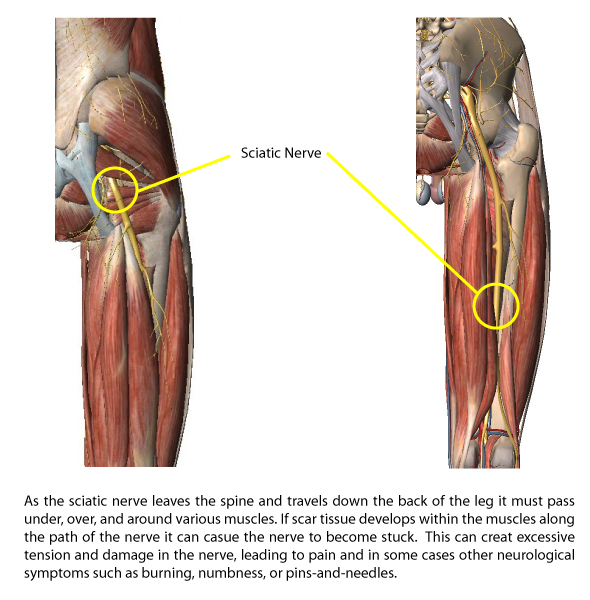Scar Tissue and Pain: Part 3
Scar Tissue Adhesions and Nerve Restriction
As discussed in the previous two articles, as scar tissue adhesions are formed along and between muscles it can restrict the flexibility and relative motion of adjacent muscles necessary for normal body movements. As process that will eventually lead to pain and tissue imjury. The third major area that can be compromised by scar tissue adhesion formation is nerve function, which will be covered in this article.
Basic Anatomy of the Nervous System
As the spinal cord descends from the head down through the spinal canal it gives off small nerve root branches. These nerve roots weave together to form several larger peripheral nerves that supply the muscles, joints, skin, blood vessles, and internal organs. These nerves act as an information highway, carrying neuro-chemicall messages about muscle stretch and contraction, tissue injury, and pain between the central nervous system and the body.
As these peripheral nerves travel from the spine to their various destinations within the body they must pass under, around, and in some cases though muscles and other bony or soft tissue structures. These tissues essentially form a container through which the nerve must travel (see image for an example of the path of the sciatic nerve).
[responsive] [/responsive]
[/responsive]
Scar Tissue and Nerve Damage
Just as the different muscles need to be able to move and slide against each other for healthy movemet, the nerves also need to be able to move and slide against the surrounding muscles as you move and adopt various postures and positions. In fact, as you move your arms and legs many of these nerves will actually need to slide as much as an inch or more within their ‘containers’.
However, if scar tissue adhesions form in an area where a nerve passes under or along a muscle, the scar tissue can actually cause the nerve to become stuck or adhered to the surronding tissue. This will prevent the normal and necessary sliding of the nerve. If the nerve cannot slide it will strech with movement, which can lead to nerve damage or injury.
In the early stages this is typically felt as muscle tightness and/or difficulty moving through a full range of motion. But over time as the nerve becomes inflamed or damaged it can cause pain as well as other classic neurological symptoms such as numbness, burning, weakness, or pins-and-needles to develop.
Resolving Scar Tissue Adhesions with Active Release Techniques
As you can see from this article series, scar tissue adhesions can be a major problem. Fortunatley, scar tissue adhesions that develop in or between muscles, or along the path of nerves can be treated. One of the quickest and most effective methods to do this is with a specialized soft tissue treatment method known as Active Release Techniques, or ‘ART’.
We have written about ART in other areas of our website (check our out ART page for more detailed information), but I will provide a brief review here as well.
ART is a hands-on treatment method that it is designed to identify and address scar tissue adhesions that are interfering with the normal function of the body. By locating and treating the soft-tissue adhesions with ART, it allows us to 1) break-up restrictive adhesions, 2) restore normal tissue translation and movement and 3) more completely restore strength, flexibility, balance, and stability to the hip and surrounding area.
You can think of an ART treatment as a type of active massage. The practitioner will first shorten the muscle, tendon, ligament, or joint capsule, and then apply a very specific tension with their hands as you actively stretch and lengthen the tissues. As the tissue lengthens the practitioner is able to assess the texture and tension of the tissue to determine if the tissue is healthy or contains scar tissue that needs further treatment.
When scar tissue adhesions are felt the amount and direction of tension can be modified to treat the problematic area. There are over 500 specific ART treatment protocols which allow the practitioner to “feel” which structures have become problematic and require treatment – there are even specific protocols to help ‘release’ different muscles that have become stuck together, and to release entrapped nerves that are not moving and sliding properly.
How Fast Can ART Treatment Help with Hip Pain?
One of the best things about ART is how fast it can get results. In our experience, the majority of muscle and joint problems respond very well to ART treatments, especially when combined with home stretching and strengthening exercises. Although each case is unique and there are several factors that will determine the length of time it will require to fully resolve the condition, we usually find a significant improvement can be gained in just 3-4 treatments.
